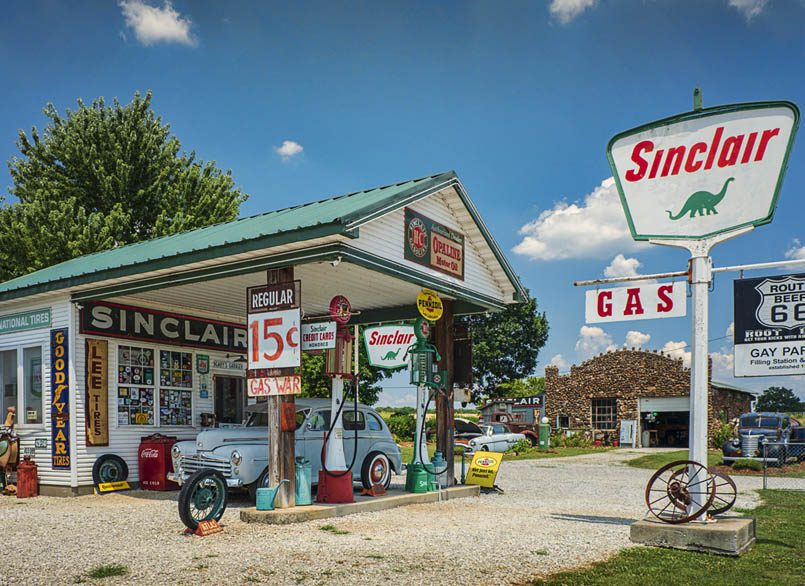18 Feb 2019 Travel down the Mother Road
by Linda Henderson
Winter, or what we call Netflix Amazon Prime season, is just about over. Spring will shortly be making its appearance and as the weather warms, my desire to travel will emerge.
Last year, my husband Jim asked me, “What do you want for your birthday?” My response was, “Route 66.” His response was, “The whole thing”? I said, “No, not the whole thing, just parts of it.” That’s how an adventure out of the 501 started.
I have had an interest in Route 66 for many years and have always planned a photography trip down the road. I have bought many guide books and maps on the subject and have searched the internet for hours for the best roadside stops.
After many years of planning, Jim and I are starting on an epic quest to travel the whole road from start to finish.

Because there are too many things to see, discover, photograph and taste along Route 66, we are going to break it up by driving sections at a time. The first section we explored is Lebanon, Mo., to Geary, Okla. Our plans were to eat in only small town diners and stay in vintage motels and motor courts along the road.
The American public was introduced to the “Mother Road” in 1926. US 66 was established on Nov. 11, 1926, with road signs erected the following year. It started as a collection of farm roads that connected rural America to industrial America. Originally the road was only paved for a very short distance. The majority of the road was long stretches of dusty unpaved roads.
The old road crosses eight states and covers more than 2,400 miles from Chicago through Missouri, Kansas, Oklahoma, Texas, New Mexico, Arizona and finally across the Mojave Desert to Los Angeles. It passes through countless small town main streets, giving it another nickname of “America’s Main Street.” Route 66 covers three time zones and was the first continuous paved road in the United States. Today, between 80 to 85 percent of the road still exists. The number of the road may have changed or may have been by-passed for another route, but with planning and careful map reading, a majority of the old road can be followed.
It represents so many things and people in America’s past, like John Steinbeck and Will Rogers. It represents “Okies and Arkies” escaping crop failures and the Dust Bowl of the 1930s. It is interwoven into the American history as the path to hope during the Great Depression. It is the road that carried away and brought the “boys” home during World War II. It is celebrated in America’s musical genres of Rock-In-Roll and Folk music. It showcased America’s brands of transportation like Ford, Chevy, Dodge and Harley.
Road food was birthed on the “Mother Road” in mom and pop diners serving greasy burgers and plate lunches. The Route 66 inspired cafes and diners that have now spread from coast to coast.
Travel necessities such as truck stops, auto repair garages, small independent filling stations and motor courts sprang from travel down this long road. Americans with an entrepreneurial spirit built road side attractions along the way to lure travelers to spend money and buy souvenirs to remind them of their time on Route 66.

A wide variety of man-made landmarks are features on the road, like the Gateway Arch in St. Louis, teepee motels, curiosities like snake pits or alligator farms, a concrete blue whale, bus stops, trading posts, historical bridges, giant muffler men, old road signage, movie theaters, monuments and all sort of museums celebrating everything from cars to cowboys.
Natural features of our great land are found on Route 66, including the Grand Canyon, Ozark Mountains, the Great Plains, farm land growing all types and kinds of produce, the Petrified Forest, Painted Cliffs, caverns, desert landscapes and the Painted Desert. Old ghost towns can be found in the more remote sections of the road.
A revival and preservation of the old road started in the late 1980s. Many communities along the road banded together to update and renovate their declining and aging main streets. Government grants for restoration have been awarded to many historical sites and buildings adjacent to the route.
In the early 1990s, international travelers became interested in not only the history but also in traveling the road and the surrounding areas of the Route 66 corridor. Many Europeans are drawn to the wide open spaces of the American West. Other international travels are attracted to the Middle America portion of the Route, wanting to experience a taste of small-town America far from bright city lights. In recent years, there has been a boom in tourism and Route 66 has become a vacation destination.
The road is truly a representation of America the Beautiful. Route 66 has a rich and long history. A quote by an unknown author sums it up well, “Route 66 is the pulse of the American dream and the embodiment of the American Spirit that we are still looking for.” I have found that to be true as we travel down Route 66. The road has become an American myth and legend of America culture from a by-gone time when life was a little slower, the roads were a little narrower and a surprise was just around the curve. The U.S. interstate systems are fast and straight, and for the most part the scenery rarely changes. I find the old roads to be filled with friendly ghosts of the past and the essence of the American character. I want my travels to always be down the slower roads of America.
What do I want for my 2019 birthday? Head West!
- Getting the shot of a lifetime - February 1, 2024
- The road to Gothic Mountain - October 9, 2023
- Picture it - April 3, 2023











